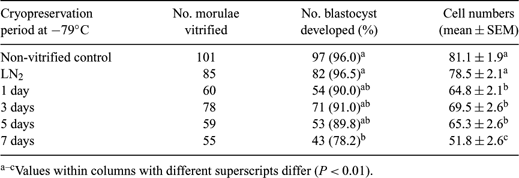135 SHORT-TERM CRYOPRESERVATION OF VITRIFIED MOUSE MORULAE AT −79°C
Y. Takagi A , M. Shimizu A , M. Morimura A , S. Yokomizo A , K. Hara A and M. Sakamoto AAFaculty of Agriculture, Shinshu University, 8304 Minamiminowa, Nagano 399-4598, Japan
Reproduction, Fertility and Development 19(1) 185-185 https://doi.org/10.1071/RDv19n1Ab135
Submitted: 12 October 2006 Accepted: 12 October 2006 Published: 12 December 2006
Abstract
Embryos of various species are successfully vitrified and cryopreserved in liquid nitrogen (<−150°C). Like the preservation of frozen somatic cells cooled by dry ice (−79°C), the cryopreservation of embryos at −79°C is useful for a reduction in the shipping costs. The purpose of this study was to evaluate the effect of the cryopreservation period at −79°C on the in vitro embryo viability of vitrified mouse morulae after thawing. Morula-stage mouse embryos were collected from superovulated ICR donors 70 h after hCG injection. The embryos were exposed first to 5% DMSO + 5% ethylene glycol (EG) in Dulbecco's PBS + 20% FCS (mPBS) for 2 min, and then equilibrated for 20–30 s in a vitrification solution composed of 10% DMSO + 10% EG + 0.6 M sucrose in mPBS. The embryos were loaded onto cryoloops (Lane et al. 1999 Nat. Biotech. 17, 1234–1236) and plunged directly into liquid nitrogen. The cryoloops were placed in 1.2-mL cryotubes and stored in a −79°C freezer for 1–7 days. The embryos were warmed by passing through 4 dilution media and rinsed with mWM culture medium. They were then cultured at 37°C in 5% CO2 for 44 h. Non-cryopreserved embryos and embryos cryopreserved in liquid nitrogen served as controls. Data were analyzed by the chi-square test and the Student's t-test. Results are shown in Table 1. There was no significant difference (P > 0.01) in the developmental abilities to the blastocyst stage of the vitrified embryos that were cryopreserved at −79°C for 1 day, 3 days, and 5 days, the embryos cryopreserved in liquid nitrogen, and the non-vitrified control. The blastocyst rate of embryos was significantly lower (P < 0.01) for the Day 7 group than for the control group. The cell numbers of blastocysts were significantly lower (P < 0.01) for the Day 1, Day 3, Day 5, and Day 7 groups than for the control group. This study suggests that vitrified mouse morulae can be successfully cryopreserved at −79°C for 5 days.

|


